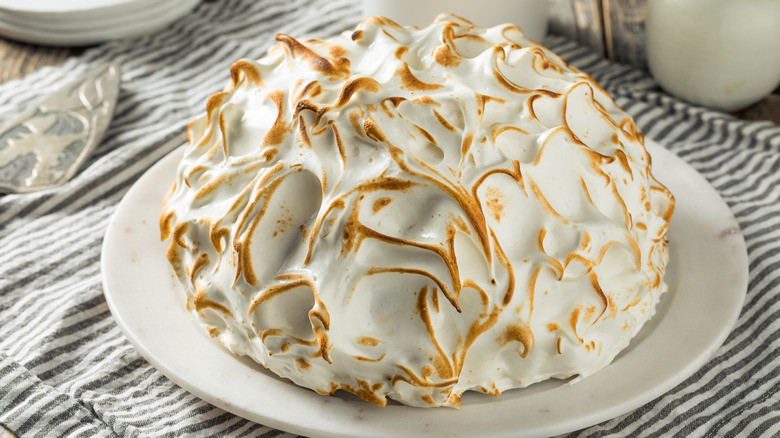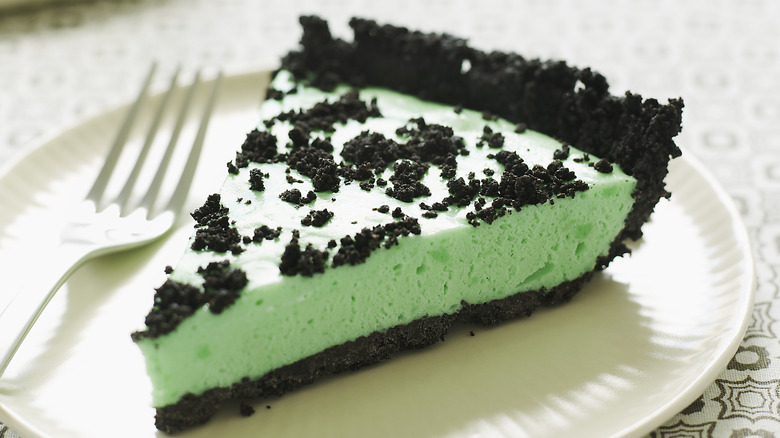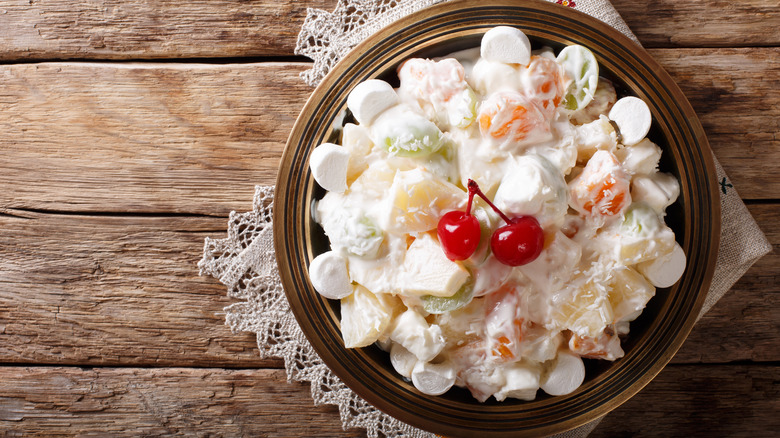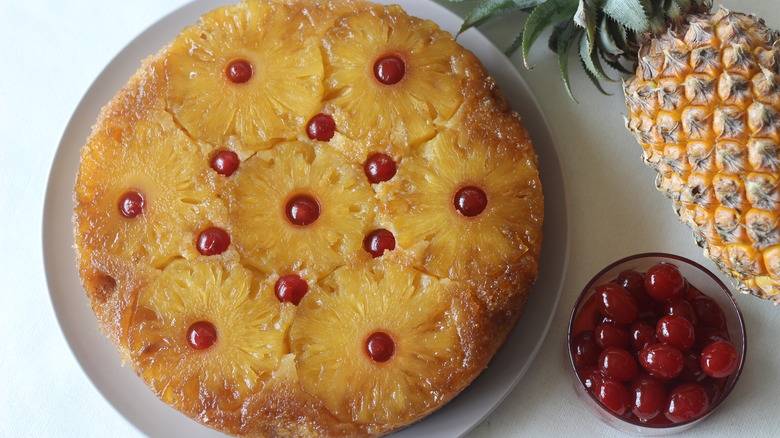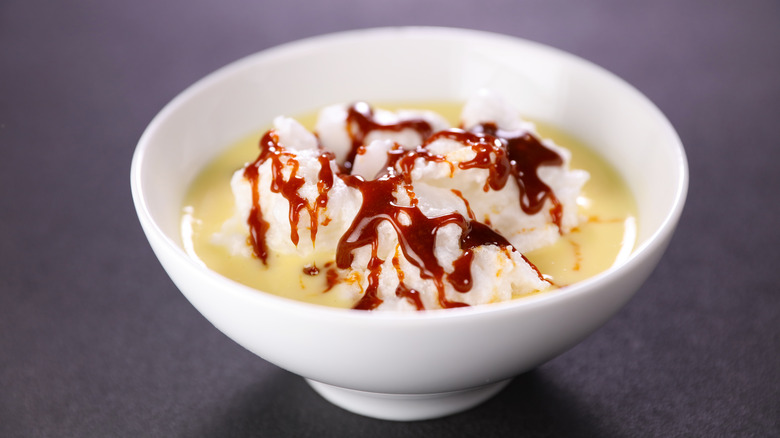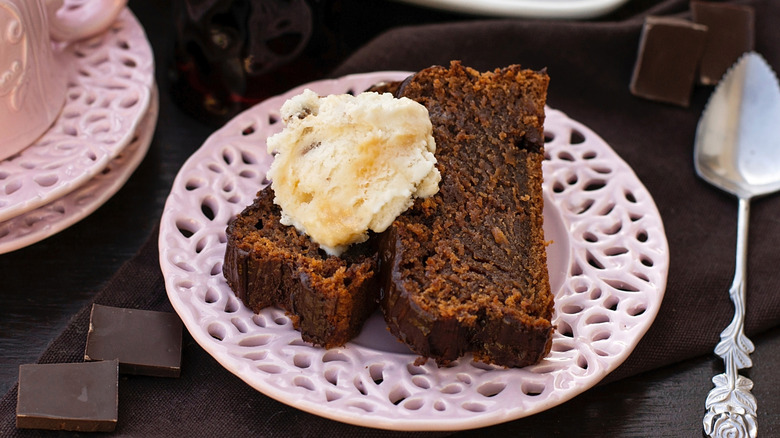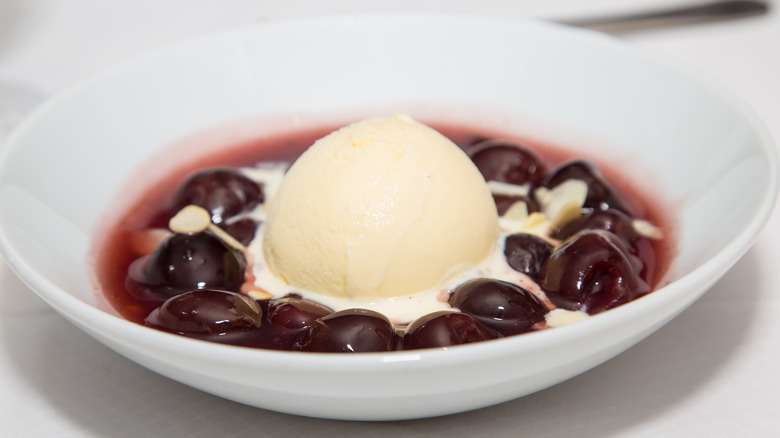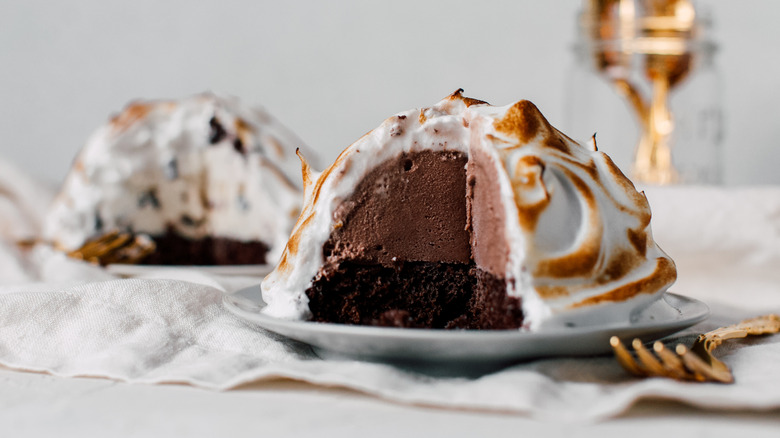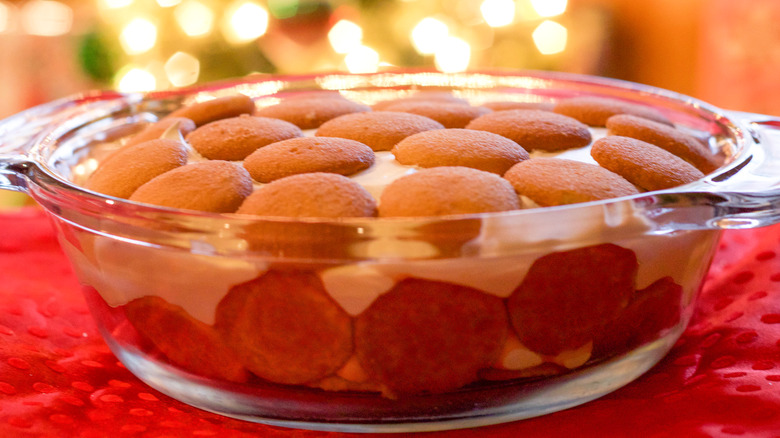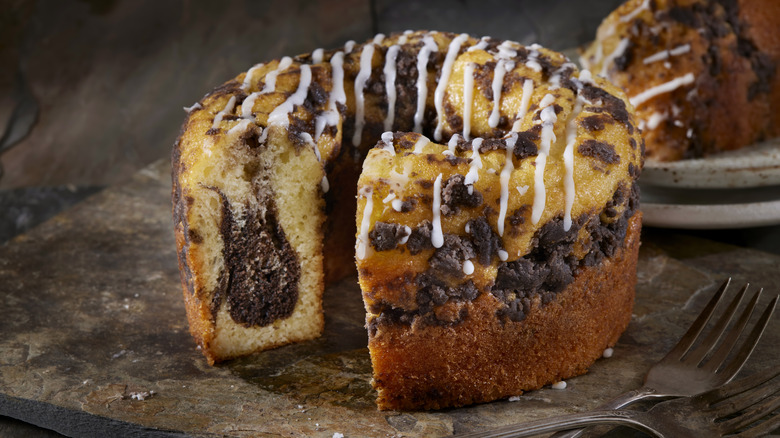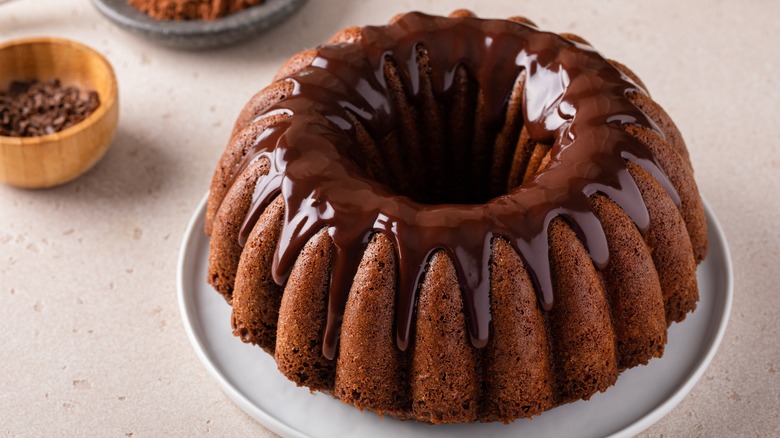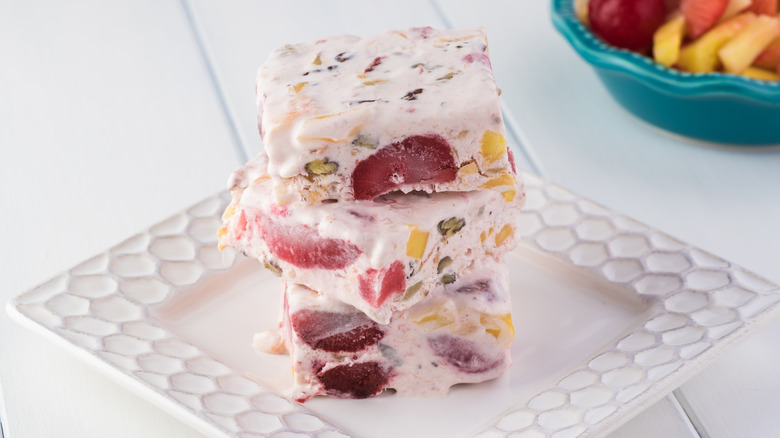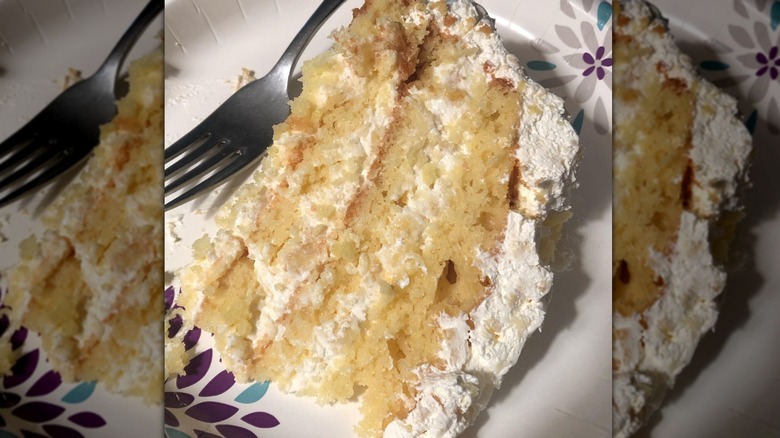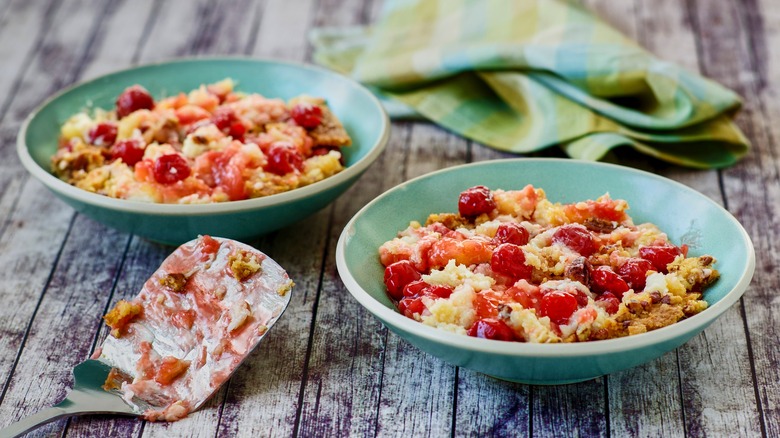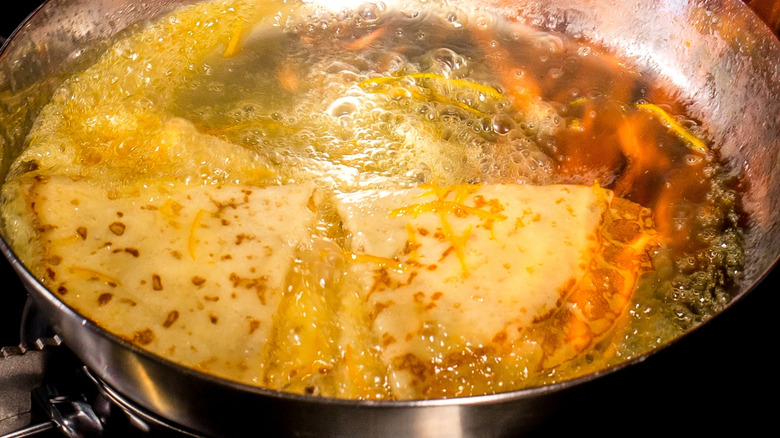Old-Timey Desserts That Were Huge In The '60s
Food trends wax and wane with the times, with dishes falling in and out of vogue for a variety of reasons. The 1960s were a period rich with wondrous desserts, many of which have faded from the public consciousness. During the '60s, times were a'changin and women were entering the workforce in higher numbers than ever. As a result, desserts began to evolve. Food manufacturers observed the shift, and new products entered the market to either expedite the cooking process or eliminate it altogether.
American kitchens were obsessed with Jell-O, marshmallows, and using convenient canned fruits like pineapple to fashion quick, low-maintenance fare that could be quickly whipped up for a bite of something sweet after the family dinner. Additionally, chefs were inspired by international cuisines, many of which were brought to America's attention by Julia Child, leading to desserts with stunning presentations to be enjoyed on a celebratory evening out.
While these toothsome creations are not as "far out" as some other '60s era-dishes, such as gelatinized salad, they are equally as intriguing. Some seem due for a resurgence, while others — like Watergate dessert salad — seem best left in the dust. Cruise into the wild past of the 1960s to discover a realm of retro cakes, pies, and puddings. From fluffy, gelatinized fruit salads to high-end dishes set aflame, the swinging '60s were indeed a memorable decade for desserts.
Grasshopper pie
Grasshopper pie was all the rage in the 1960s. Named after the cocktail, this chilled, no-bake pie held the flavors of mint and chocolate, delivered in airy, chiffon-like bites. Called grasshopper pie to mirror the similar coloring and ingredient use as the grasshopper cocktail (which contains the liqueurs white creme de menthe and creme de cacao mixed with half and half), this insect-free pie was fashioned from creme de menthe and creme de cacao, mixed with whipped cream, melted marshmallows, and dairy, all encased in a chocolate crust.
Marshmallows helped the pie to set, but some recipes also made use of gelatin or egg whites to keep the center firm. In the 1960s, its popularity stemmed from its ease, needing no oven, and its ability to be made ahead of time. The dessert was particularly popular in the late '60s. This classic pie has experienced a revival as of late, with its pastel-green coloring making it an ideal dessert for Easter or St. Patrick's Day. Modern recipes tend to use marshmallow fluff and crushed Oreo cookies or crushed thin mints.
Ambrosia salad
Another nostalgic dessert many flower children might remember from their childhood is ambrosia salad. Ambrosia salad was an easy to assemble dessert that often made use of canned fruit, including pineapple, mandarin oranges, and maraschino cherries. Often made from sour cream and whipped cream mixed with canned fruit cocktail, marshmallows, and shredded coconut, this fluffy fruit salad once delighted adults and children alike across America.
This creamy fruit salad existed as a '60s staple at family gatherings and potlucks particularly in the Midwest and South. It travelled well and required minimal preparation, making it a common fare for dinners and holidays. Yet its popularity extends back far further. Incarnations of the recipe date back way before the 1960s, back to the Gilded Age when the ingredients were considered more unique and difficult to find.
This sheds a little light on the name, given that ambrosia meant "food of the gods." It was not until oranges reached mass distribution and year-round access to fruits became possible that the middle classes began to adopt the dessert, making it a '60s essential. In the South, this classic dessert still makes the rounds at many holiday tables, with more modern versions of the dish including elements like yogurt, pecans, and fresh apples.
Pineapple upside down cake
Although you will find recipes for this tropical-flavored cake dating back decades earlier, pineapple upside down cake became a 1960s favorite. This retro-style dessert is essentially a skillet cake, made by placing canned pineapple slices and brown sugar in a pan, covering it with cake batter, and baking. Once finished, the cake was flipped, giving it the upside-down name, leaving a sticky caramelized brown coating as the top. Some more creative versions of the dessert often incorporated canned cherries into the recipe, placing a maraschino cherry inside each pineapple round for a decorative effect.
Although pineapple upside down cake was by far the most popular in the '60s, it was not the only inverted dessert to use this technique. Before upside down cakes, there were skillet cakes, where desserts were made in cast-iron skillets on the stove top during times when ovens were less common. The first skillet cakes were made with apples and cherries, while later upside down cakes used peaches, apricots, or prunes.
Floating island
Very popular from the 1960s to the 1980s, floating island hails from French cuisine. Composed of baked meringue surrounded by pools of custard and drizzled with caramel, this creamy dessert gained popularity during the mid century modern era, as eggs and milk were relatively inexpensive during the time. The dish actually has lengthy roots, stretching all the way back to 1600s-era France with its earlier manifestation: a baked dish of egg whites topped with egg yolks and dusted with sugar, aptly named eggs in snow.
Floating island was a favorite dessert of chef Julia Child, who included a recipe for her take on the dish in her 1961 cookbook. Known as île flottante in French, the dish began showing up at renowned restaurant Le Cirque in New York City, further expanding the dessert to a U.S. audience.
Coca Cola cake
Cakes fashioned with soda have long existed as a popular dessert in the South. Made with cocoa powder, buttermilk, and Coca Cola, some versions of this dessert also included frosting the cake with a cola-flavored icing. The bubbles in this carbonated beverage work as an additional leavening agent, rendering a cake that is especially light and moist. Adding soda to cake mix has long been a handy trick for cooks short on ingredients, as soda eliminates the need for eggs, oil, or water in cakes.
In the 1960s, Coca Cola cake garnered much attention, with this chocolatey cake often being accompanied by marshmallows and nuts. Despite what you might think, Coca Cola cake didn't taste like the soda at all. Instead, it harbored a chocolatey, rich flavor. Some versions of this rich cake omit the marshmallows, instead blending spices such as ginger, star anise, and ginger into the mix.
Cherries jubilee
Cherries jubilee is another historic dessert that rose to popularity in the '60s. Originally credited to Auguste Escoffier who invented it for Queen Victoria for her Diamond Jubilee celebration circa 1897, the dish evolved to brandish cherries poached in syrup, topped with brandy so it could be set aflame, and presented atop vanilla ice cream. It gained popularity alongside the increase of restaurants who began adopting the dessert after Julia Child featured it on television.
While its heyday resided in the '60s and '70s in the United States, the dessert's celebrity status dwindled as the '80s approached, with restaurants dropping much of the table-side spectacle that had helped the dish rise to fame in earlier years. Today, the dish is seldom found on restaurant menus, although a few New York restaurants have attempted to revive its popularity as of late, keeping the tradition of its table-side preparation intact.
Baked Alaska
Perhaps the most sensational looking of all 1960s desserts is the icy fare known as baked Alaska. Built from a bed of cake topped with frozen ice cream, this chilled concoction was then wrapped in meringue and toasted. Because the meringue acts as an insulator, it keeps the ice cream within from melting, protecting it from the heat, making for a nostalgic dessert that is intriguing in appearance and delightfully frosty inside.
Although baked Alaska was invented long before the 1960s, it experienced a strong resurgence during this period due to Alaska being granted statehood in 1959. Pioneered in 1876, a handful of years after the U.S. acquired the Alaska territory, its origins actually stretch back even further. Its ancestor was a French dessert known as omelette Norwegge, named after France's Northern neighbor Norway. Older incarnations of the recipe required a broiler, but newer takes on the dish made use of blowtorches to create the browned meringue casing. While the original baked Alaska was fashioned from banana ice cream and walnut spice cake, '60s versions would expand the flavor profile further using different varieties of ice cream and cake.
Banana pudding
Banana pudding became a regular dish in the 1960s as previously difficult to find ingredients like bananas became more accessible and affordable to the general public. The introduction of larger-laned highways in the South during the '60s allowed trucks to move and deliver bananas to grocery stores far quicker, reducing the price of the fruit tremendously, helping to make the dessert especially popular in that region.
As a result, banana pudding began to pop up everywhere in the 1960s, often made from prepackaged cookies, custard, and ripe bananas. Stores began to take notice of the trend, placing vanilla wafers alongside bananas for ease of purchase. Although incarnations of banana pudding existed for decades, the '60s incorporated store-bought cookies into the mix, replacing more time-consuming fillings like lady fingers or sponge cake found in older recipes. Once Cool Whip came on the market in 1966, the process became even easier along with the help of Jell-O's 1964 banana pudding mix.
Coffee cake
Long cherished in Europe, Americans have the German and Dutch to thank for this appetizing 1960s favorite — one which arguably deserves a comeback, though thankfully it hasn't disappeared to the extent that some of these other desserts have over time. Despite what the name implies, coffee cake contains no coffee, instead being titled for its preferred pairing with this morning brew. Its sensational flavors ranged from nutty and spicy to fruitier varieties, such as apple. Although coffee cake dates back to the 1800s in America, their popularity rose during the 1960s after the introduction of the bundt pan in the '50s made it easier for heavy batters and denser fillings to be used.
The 1960s recipes usually involved crafting a batter which was then divided in two. Half the batter would fill the bottom of the bundt pan, then a layer of filling would be added before the rest of the batter was applied on top. Recipes included everything from lemon extract and walnuts, pecans and cinnamon, to pineapple and coconut. Sour cream was also a frequent ingredient, yielding a cake that was exceptionally moist and tender, but with a finer crumb.
Tunnel of fudge
No 1960s party should be complete without this fudge-filled delight. The tunnel of fudge cake drew much attention in the later '60s, after the recipe claimed second place in the 17th Pillsbury Annual Bake Off. Baked in a bundt pan, this circular dessert involved a moist chocolate cake enveloping a ring of hot fudge to be released when sliced.
The fascinating recipe is sadly impossible to recreate in its original form today. The current recipe listed on Pillsbury's site calls for cocoa powder, but the original recipe entered by Ella Helfich in the 1966 Bake Off used a powdered frosting mix, specifically Pillsbury's Two Layer Size Double Dutch Fudge Buttercream Frosting Mix. No longer in existence today, Baby Boomers continue to lament the loss of this seemingly integral ingredient, although additional recipes have tried to replicate the gooey chocolate interior by undercooking the cake or supplying chocolate pudding in the center.
Frozen fruit salad
Very popular in the '50s and '60s, frozen fruit salad was considered a summer staple by many. Convenient recipes usually included ingredients like canned fruit and marshmallows blended with a creamy base that was frozen and sliced. The most convenient recipes included simple pantry ingredients like fruit cocktail mixed with Cool Whip, a refrigerated necessity for many at the time. Some recipes also incorporated Jell-O and sliced nuts leading to a mosaic-like dessert, perfect for providing a cooling, sweet bite.
Classic recipes included fruits like pineapple, grapes, and maraschino cherries, combined with whipped cream (preferably homemade), plus a touch of lemon juice and mayonnaise to mellow the sweetness. Placed in a cake pan, the dessert could then be sliced into stunning individual servings once frozen.
Pineapple icebox dessert
A lesser known recipe from the 1960s, pineapple icebox dessert features vanilla wafers, dairy, gelatin, and what may possibly be the '60s most popular fruit: canned pineapple. Icebox cakes like these were no-bake desserts, often assembled from cookies, dairy, and fruit left to set in a refrigerator. Named to reflect the ice boxes they were kept in before modern-day refrigerators were invented, icebox cakes were personalizable, easy to prepare desserts. Largely popular in the 1960s, the pineapple icebox cake was a chilled, jiggly delight for bringing to gatherings and parties of the time.
The ingredients for such creations varied by whoever was building the dessert. Some recipes added nuts and cherries, or gave the top layer a dusting of crumbled vanilla wafers. Other recipes utilized crushed graham crackers and lemon jello, mixed with finely chopped pineapple. Calling it cake may seem a bit misleading, as the dessert isn't made with a batter. The cake portion is made from cookies or wafers that soften as the cake chills. The texture becomes spongy, but never mushy, somewhat similar to Italian tiramisu. They may not be as decadent in appearance as other 1960s cakes, but they are equally as delectable.
Dump cake
Unlike what the name may lead you to believe, dump cake was not something to eat after your beau broke your heart. This cobbler-like cake was one that could be made in a hurry, simply requiring you to "dump" the content of canned pie filling or tinned fruit into a pan along with a boxed cake mix and melted butter. Stirring wasn't even needed — the medley would just be popped in the oven to crisp up like a fruit cobbler. The result was a texturally rich dessert, wonderful for pairing with ice cream or Cool Whip.
Dump cakes experienced increased popularity in the '60s due to the prevalence of cake mixes in supermarkets. Dump cake recipes were frequently featured on these boxed mixes in an attempt to encourage shoppers to purchase their products. Common ingredients in the 1960s included yellow box cake mix, cherry pie filling, chopped nuts, crushed pineapple, and a full stick of butter. Other recipes used blueberries, peaches, or apples, oftentimes featuring whatever fruit was on hand at the moment.
Crepes Suzette
A passion for crepes began in the '60s, which would stretch through the '70s before fizzling away as the '80s came to a close. Yet at its peak, Crepes Suzette was seen as an exceptionally refined dish, only being featured at pricier restaurants, like the Hotel Astor. Popularized by Julia Child on the French Chef, and considered to be among her favorite recipes, the dish consisted of hot crepes gilded with a sweetened orange sauce often made with Grand Marnier, adorned with brandy, and usually lit for effect table-side.
The dish had been popular in France much longer than America, having been invented by a 14-year-old assistant waiter in 1895, according to legend. As the tale is told, the recipe was developed by mistake when the cordials caught fire as the boy was preparing a dish for the Prince of Wales. Luckily, it turns out Crepes Suzette was a dish exceptional enough to be fit for a king as well as posh '60s connoisseurs.

